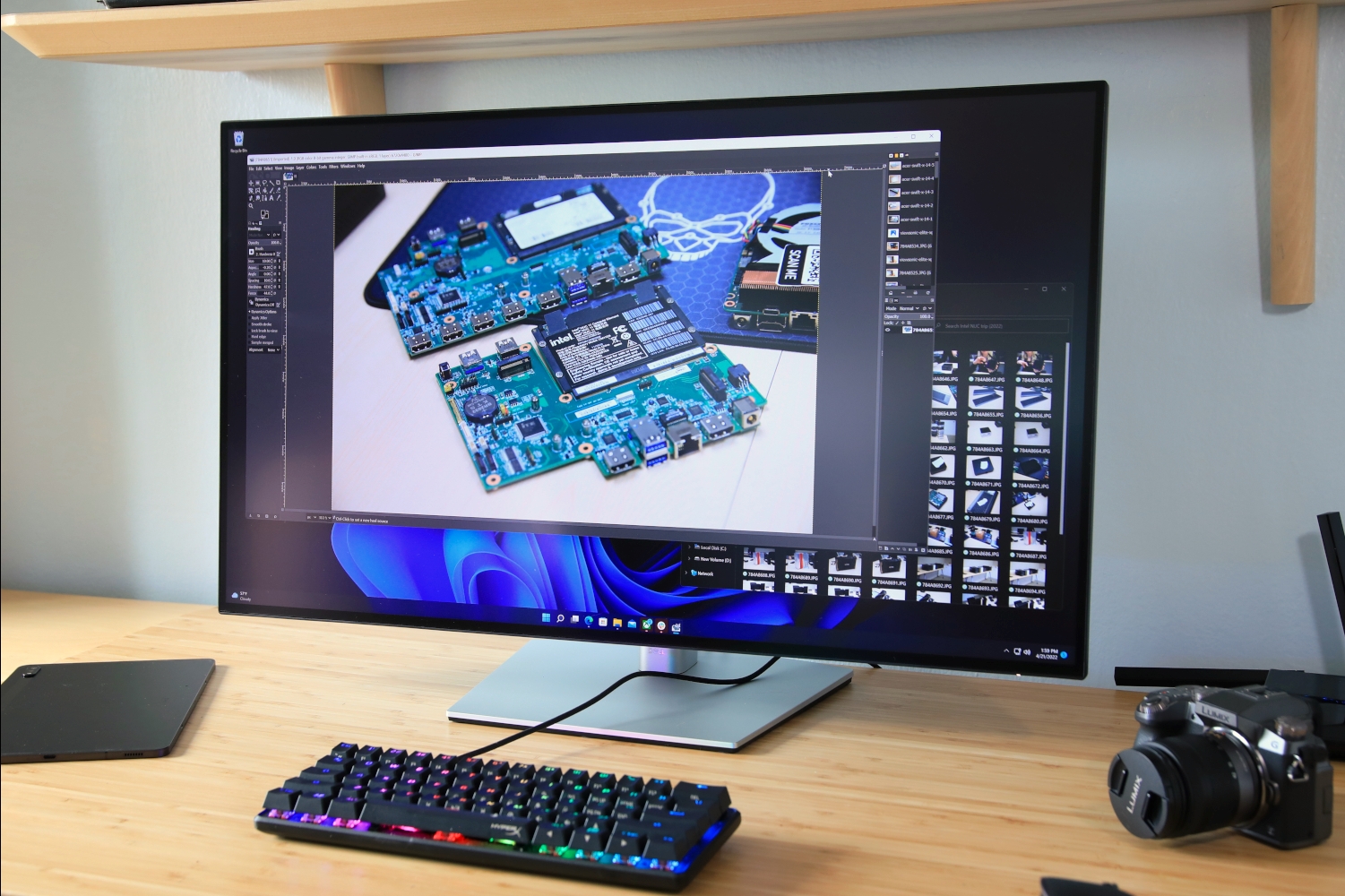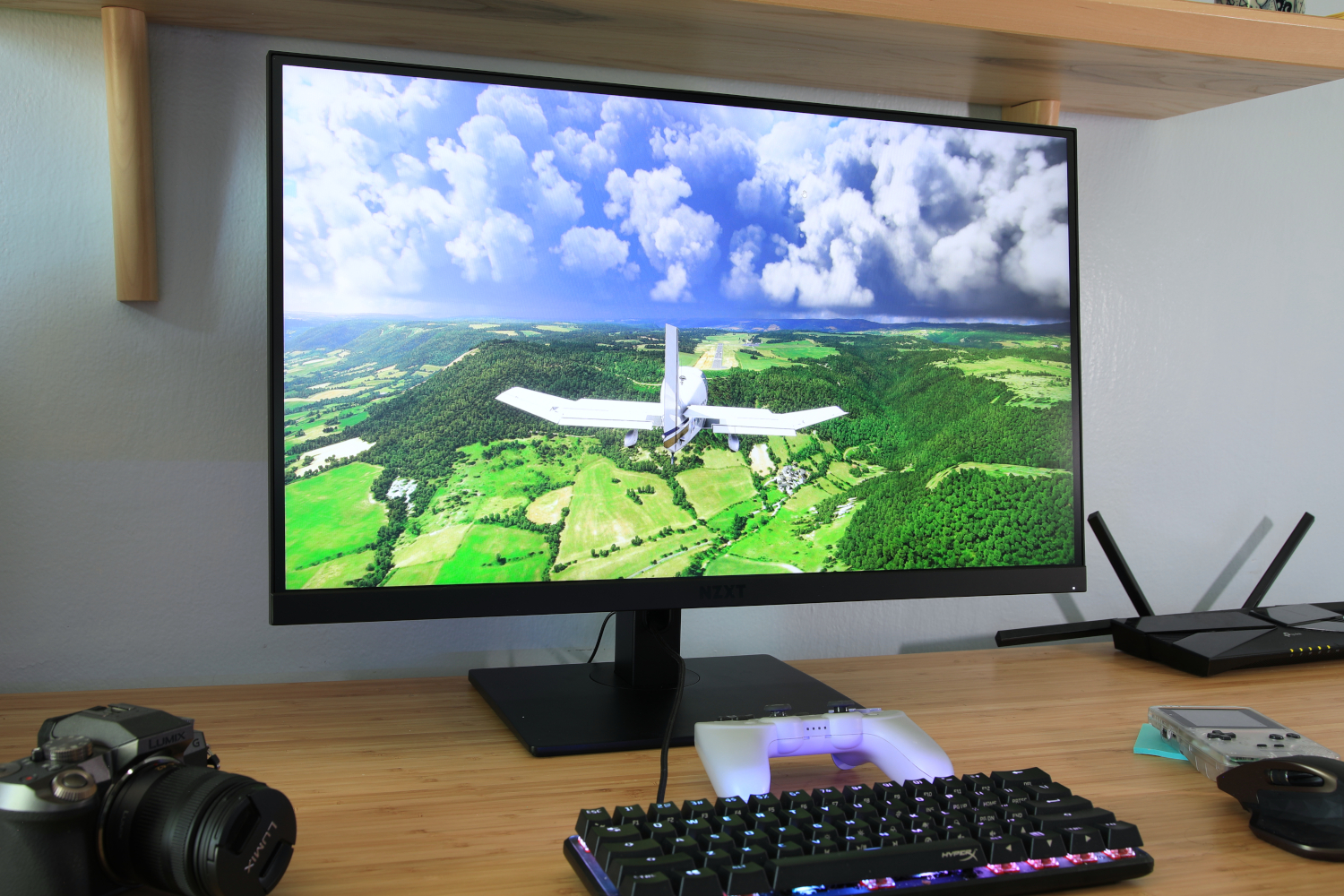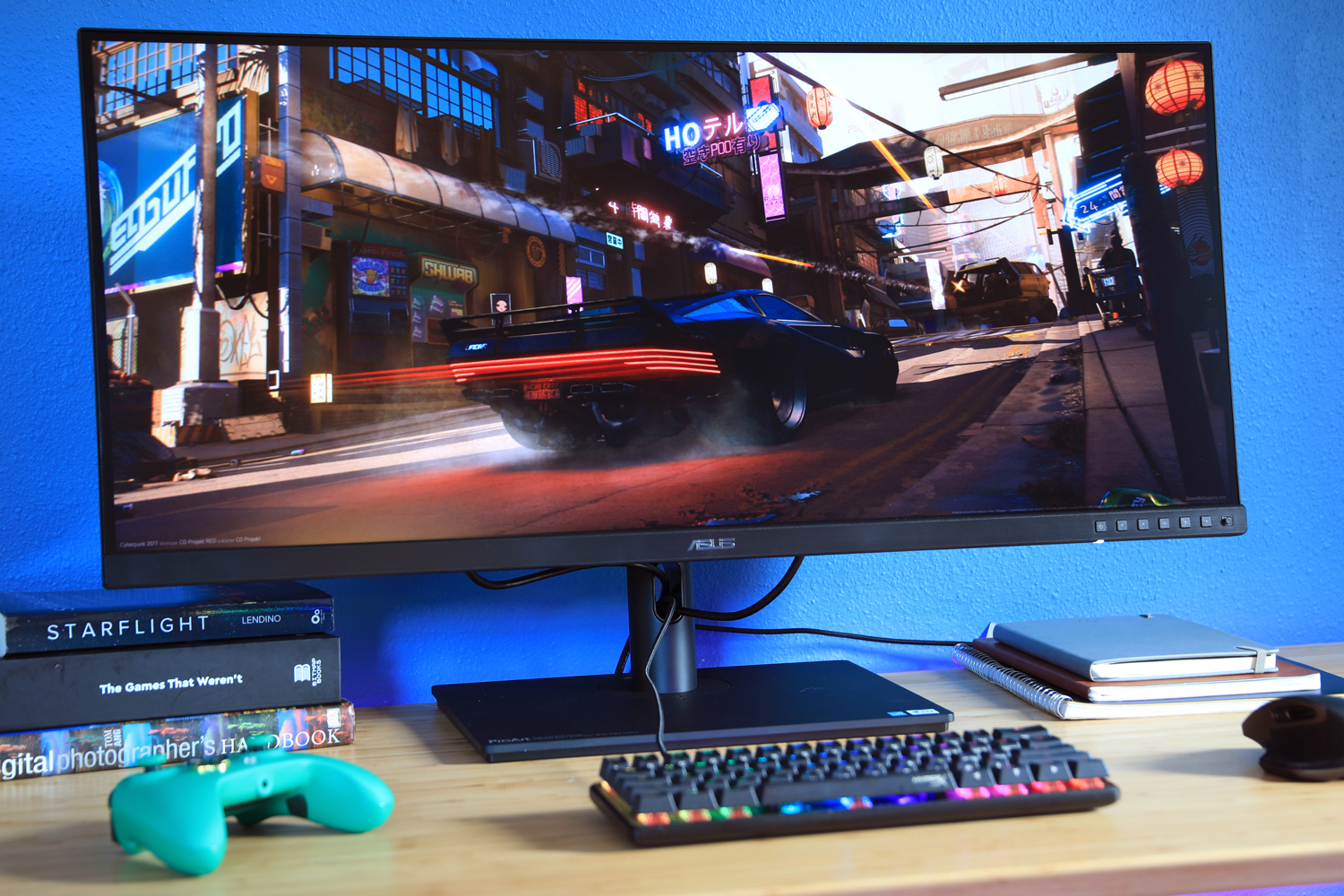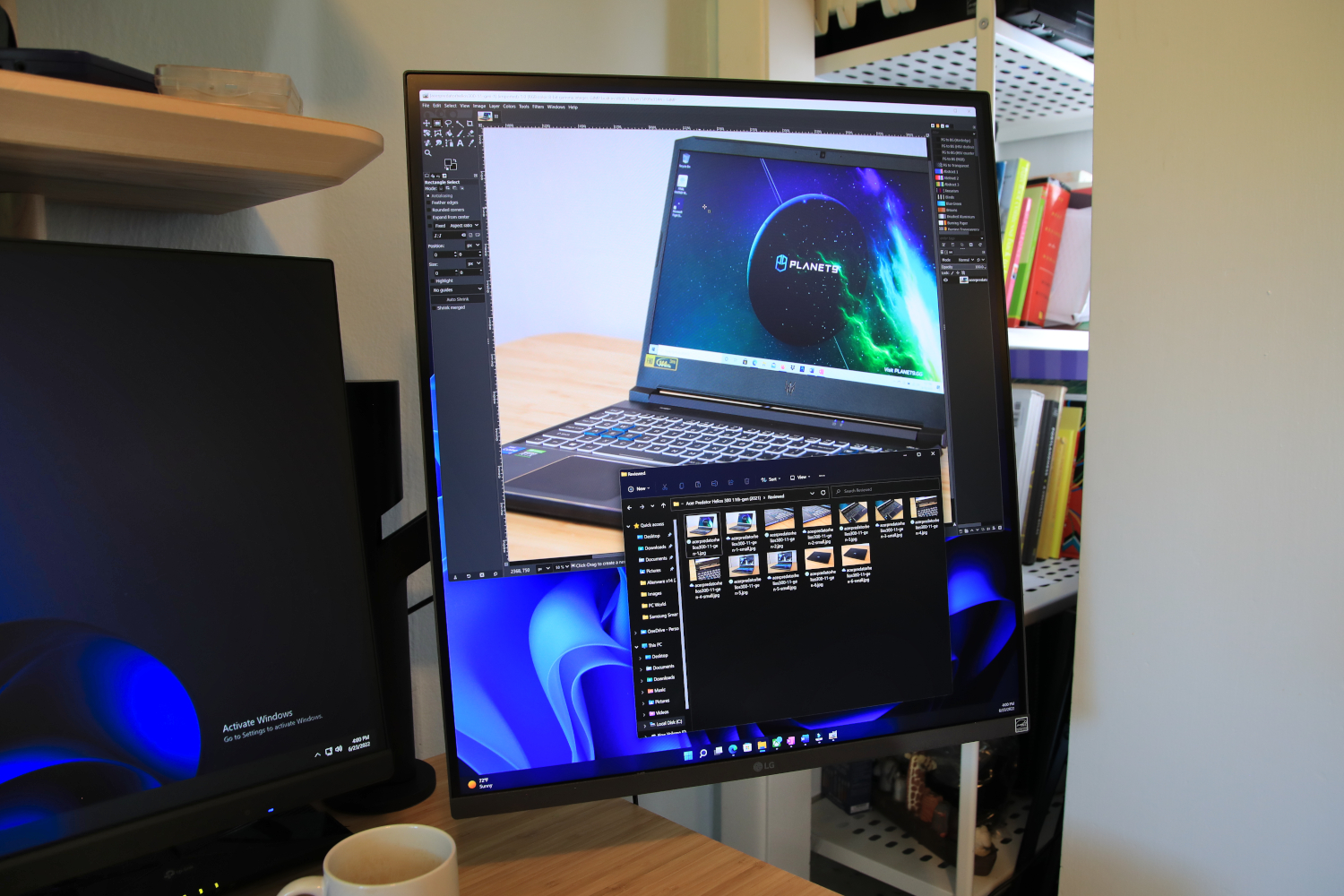USB-C is the one connection to rule them all—literally, in many cases, thanks to a recent law passed by the European Parliament. Its popularity has made USB-C a common sight on new monitors. A USB-C monitor can easily connect with a wide range of devices, from laptops to smartphones; and some USB-C monitors can even charge a connected device while in use.
The details of USB-C can be confusing, however, and pricing for USB-C monitors is often higher than that for monitors that lack the interface. Our guide to the best USB-C monitors will help you pick the right display for your needs.
To learn more, see our section on what to look for in a USB-C monitor below our recommendations.
1. Dell U3223QE – Best USB-C monitor overall

Pros
- IPS Black panel fulfills its promise
- Accurate color with wide gamut
- High brightness in SDR
- USB-C hub with 90 watts of power
Cons
- Edges of display are noticeably bright
- HDR performance disappoints
- Only a 60Hz panel
The Dell U3223QE, which ranks as our best monitor overall, is an excellent USB-C monitor with a huge range of connectivity. It also packs a cutting-edge IPS panel with alluring image quality.
Connectivity is excellent. The monitor has a USB-C port with DisplayPort Alternate Mode and up to 90 watts of Power Delivery for charging a connected device. It also drives a USB hub with a total of five additional USB-A ports, ethernet, and DisplayPort-out. That’s enough to connect a wired mouse, keyboard, and display—and still have several ports left over for external drives or your smartphone.
This monitor is among the precious few with an IPS Black display panels. As the name implies, this technology improves black levels, offering roughly twice the contrast ratio of competing monitors with IPS panels. Very few monitors have this panel, so it gives the Dell U3223QE a significant edge over its competitors. The monitor also has 4K resolution and superb out-of-the-box color accuracy.
This monitor has a smaller twin, the Dell U2723QE, which packs the same features and IPS Black panel at a lower price. It’s a good choice if you don’t want a huge 32-inch monitor or do want a USB-C monitor on a more modest budget.
Read our full
Dell U3223QE review
2. NZXT Canvas 27Q – Best budget USB-C monitor

Pros
- Attractive and robust design
- Four video inputs including USB-C
- Great color performance
- High motion clarity at 144Hz and 165Hz
Cons
- Limited image quality adjustment
- Speakers not included
- HDR mode is barebones
The NZXT Canvas S27Q is the go-to choice if you want a USB-C monitor and don’t need a wide range of USB-C hub connectivity. Its more threadbare feature set helps NZXT deliver USB-C connectivity and superb image quality for less than $300.
This monitor has a USB-C port with DisplayPort Alternate Mode, meaning it can handle video input. It lacks Power Delivery, however, so the USB-C port won’t charge a connected laptop or tablet. The USB-C port connects to two additional USB-A ports. On the plus side, this monitor has two HDMI-in ports and one DisplayPort-In, for a total for four video inputs. Most affordable monitors have just two or three.
The NZXT Canvas S27Q is a 27-inch 1440p monitor with an IPS panel and a refresh rate of up to 165Hz. It also supports AMD FreeSync Premium and Nvidia G-Sync, which is good news for gamers.
The monitor has excellent image quality and scores particularly well in color performance and accuracy. It can go toe-to-toe with competitors priced $100 to $200 above it, so it’s a great choice if you want maximum value for your money.
Read our full
NZXT Canvas 27Q review
3. Asus ProArt PA348CGV – Best ultrawide USB-C monitor

Pros
- Excellent SDR image quality
- Sturdy, hefty design
- Wide range of customization
- 120Hz refresh rate
Cons
- USB-C hub lacks video-out or ethernet
- HDR is merely passable
The Asus ProArt PA348CGV is a spectacular ultrawide USB-C monitor. It manages to serve a huge range of people, from gamers to prosumers and professionals, without letting anyone down.
This monitor has a USB-C port with DisplayPort Alternate Mode and up to 90 watts of Power Delivery, so it can charge a connected laptop or table. The USB-C port can drive up to four additional USB-A ports, offering a wide range of physical connections. It doesn’t support ethernet or video-out, however, so some owners will still need an additional adapter.
Image quality is superb. Color accuracy is excellent, the color gamut is wide, and maximum brightness is high. The monitor’s 34-inch panel has a resolution of 3440×1440, which is roughly equivalent to a 27-inch 1440p monitor and looks sharp in everyday use. The monitor has a maximum refresh rate of 120Hz and supports AMD FreeSync Premium Pro, which is good news for gamers.
The ProArt PA348CGV is reasonably priced, as well, at $729.99—not a bargain, but lower than most ultrawide monitors with similar features. Its price, wide range of features, and excellent image quality make the ProArt PA348CGV a great USB-C monitor for gamers and content creators.
Read our full
Asus ProArt PA348CGV review
4. LG DualUp 28MQ780-B – Best USB-C monitor for productivity

Pros
- Unique aspect ratio is useful for photo, video editing
- Makes an awesome second monitor
- Highly adjustable stand
- Vivid, accurate color
Cons
- Difficult to fit in a small home office
- USB-C port offers limited downstream connectivity
- Can lack immersion in some content
The LG DualUp 28MQ780-B is a USB-C monitor with a unique 16:18 aspect ratio that’s almost exactly square. It can rotate into a 18:16 aspect ratio if you’d prefer. The monitor is much taller than most monitors and, as a result, has an adjustable stand that clamps to the rear of your desk instead of a normal desktop stand.
The monitor’s odd form factor is ideal for viewing large, complex documents and can be useful for editing portrait or square photos. It’s also well suited for use as a second monitor alongside a large 32-inch display.
The DualUp 28MQ780-B has a USB-C port with DisplayPort Alternate Mode and 90 watts of Power Delivery, so it can charge a connected laptop or tablet. The USB-C port can extend connectivity to two additional USB-A ports. Unfortunately, the monitor lacks ethernet or video-out, so some owners may need an additional adapter.
What about image quality? It’s great. The monitor has great color accuracy, a wide color gamut, and respectable sharpness thanks to its resolution of 2560×2880. Just be warned: The odd aspect ratio makes it a strange fit for gaming and movies. This is a monitor built for work, not play.
Read our full
LG DualUp 28MQ780-B review
What to look for in a USB-C monitor
Many features desirable in a USB-C monitor are the same as on any other display. A sharp, vivid, bright, and contrast-rich screen is best. However, shoppers who want to buy a USB-C monitor should keep an eye on details only relevant to USB-C.
Power Delivery
USB-C Power Delivery provides power over a USB-C cable. It’s not part of the core USB-C specification, so devices with USB-C (including monitors) don’t always support it. Power Delivery can pack up to 240 watts, but most USB-C monitors provide just 65 to 90 watts. It’s a perfect fit for those who own a thin-and-light laptop, 2-in-1, or tablet.
Power Delivery is inadequate for some devices, such as gaming laptops, which consume more power than current USB-C monitors can provide. These laptops may still charge when left at idle but will charge slowly (or even discharge the battery) when in use.
Ethernet
Wired ethernet is a desirable feature in a USB-C monitor. Many modern laptops lack a physical Ethernet port, so its inclusion on a monitor is convenient. It can improve the speed and reliability of a connected device’s internet connection.
While useful, this is an expensive feature available only on premium models. The Dell U3223QE is the only USB-C monitor on this list with ethernet support.
DisplayPort Alternate Mode
DisplayPort Alternate Mode is a feature available to USB-C that handles video as if the USB-C cable was a DisplayPort cable. It supports all the features you’d expect from DisplayPort including high refresh rates and adaptive sync.
A monitor without this feature won’t accept video over USB-C, meaning you’ll have to connect both USB-C and a separate video input. All the monitors on this list support DisplayPort Alternate Mode.
How we test monitors
PC World’s monitor guides are the result of independent tests by PC World staff members and freelance technology journalists.
We test each monitor with a SpyderXElite color calibration tool. This tool can measure a monitor’s brightness, contrast, color gamut, color accuracy, uniformity, gamma, color temperature, and other important aspects of display quality. Using a tool that measures objective quality helps us objectively compare dozens of monitors.
Our tests of USB-C monitors also consider the range of USB-C connectivity and features available. We prefer to see a USB-C monitor with a complete range of physical connectivity including ethernet and at least 90 watts of Power Delivery, but these desirable features are balanced against the monitor’s price.




